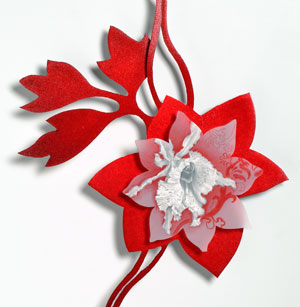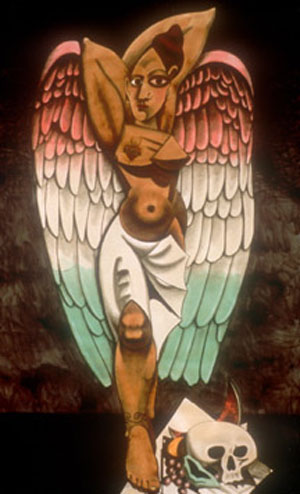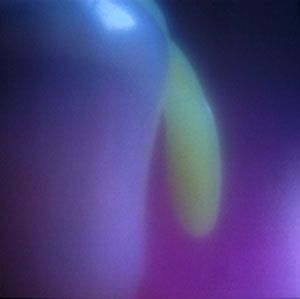
Connie Arismendi, El Reino de las Plantas (The Kingdom of Plants) …(detail), 2002 Pencil on mylar, aluminum and enamel, 60″ x 48″ x 1″
Harold Bloom’s landmark work The Anxiety of Influence discusses the pressure on writers to originate, rather than copy, the styles of their predecessors. Bloom argues that ‘strong” poets and writers “clear imaginative space for themselves” by misreading their precursors, and he recognizes different kinds of interactions, emphasizing the active roles of young writers. The Anxiety of Influence contradicts more linear narratives in which artistic efforts are said to result from the direct influence of a predecessor. Art historian Yve-Alain Bois, in a 1999 exhibition on Henri Matisse and Pablo Picasso, applied Bloom’s theory (among others) in exploring the artistic rivalry between these two artists. With Beyond the Academy, on view at Arthouse through March 9, curator Erina Duganne opens up the consideration of influence within student/mentor relationships.
Duganne positions Beyond the Academy against the theses of recent exhibitions like Public Offerings and Skeptical Belief(s) — shows which suggest that lines of influence can be drawn between artists and the schools they attended, specifically in terms of a unifying aesthetic. Duganne’s approach is more nuanced, arguing that artists develop through the complexities of individual relationships as well. Beyond presents work by six relatively established figures alongside twelve artists who see them as mentors. Michael Ray Charles, Vernon Fisher, Benito Huerta, Ken Little, Bill Lundberg, and Gael Stack are the headliners of the exhibition. All teach at universities in Texas, and are widely recognized artists. Many of their students have attained considerable standing of their own.
Duganne has brought together a stunning range of work, both in terms of media and approach. Her decision to group two students with each mentor adds an interesting dynamic. In many cases these triads reveal how individual artists are drawn to different aspects of their respective mentors” styles.
Many of the groupings reveal surprising connections between the works. Michael Ray Charles and his students Zoë Charlton and Edward Monovich are all represented by figurative paintings, and the work seems closely related in terms of thematic content. Alternately, for Connie Arismendi and Sonjia Gladbach, both pupils of Benito Huerta, Duganne has chosen to show very different works. Huerta himself is represented by Angel de Calle Studewood (1999), in which he Latinizes a figure from Picasso’s Les Desmoiselles D”Avignon. Arismendi exhibits El Reino de las Plantas (The Kingdom of Plants) (2002), a sculptural painting consisting of delicately rendered flowers floating over a bold red, vegetal ground. Gladbach is represented with Suburban Oldenberg-Sippy Cup, Suburban Sugimoto, and Suburban Serra, (all 2002), three photographs of fuzzy, indistinct imagery.
Duganne has made the admirable decision to eliminate descriptive signage from the exhibition, encouraging viewers to parse out patterns of influence on their own. But the connections between the teachers and students are not always readily apparent. A casual viewing ould probably not reveal a relationship between Little’s truncated male form, oversized and plastered in dollar bills (El, 2002), and Karen Mahaffy’s video of a dimly lit domestic interior (Untitled (you live such a pretty life), 2002). Nor is it likely that a viewer would link Fisher’s hermetic painting on blackboard (Parrot, 2002) to Martin Iles” droll music video piece (Galveston, 1998). This is due in part to the fact that the works in each grouping are not in close spatial proximity.

Benito Huerta, Angel de Calle Studewood, 1999 …Ink, watercolor, gouache and charcoal on paper, 80″ x 50″
Without more clearly defined groupings or wall text, the viewer who is interested in following the thesis of the show must muddle through who taught whom using laminated guides and Duganne’s catalogue essay. In them, Duganne suggests both threads of continuity and paths of divergence, but her comparisons ring superficial. She links the radically diverse work of Lundberg, Sue Blevins and Murray McMillan with an explanation that could arguably apply to all artwork: that the three artists ‘share an interest in social psychology and the human condition.” Also, many of the specifics are left out. Was there a particular work or series of works by a mentor that sparked something in a student? If so, how did the student respond to it, and how did it manifest itself in the student’s work? More than Duganne’s written materials, the works themselves in Beyond demonstrate that influences of mentors on their students are complex, and usually run deeper than surface similarities.
The exhibition would have benefited from the level of analysis presented in Bloom’s book or Bois’ exhibition catalogue. A critical examination of some of these relationships, an exploration into the mechanics of influence, and an acknowledgment of the active roles played by both students and mentors could only strengthen the underlying concept of the exhibition. The inclusion of more work by fewer artists — the show includes only one work by each of the mentors — could perhaps better demonstrate the complexity of connections and interactions that transpire.
However, the underlying concept of Beyond remains compelling. Duganne has selected exemplary pieces and it is a treat to see such superb work, especially knowing that it stems from relationships initiated in Texas. A more thorough analysis or fewer groupings could have strengthened the show. Whether or not one comes away with an in-depth understanding of the dynamics of student/mentor relationships, the exhibition is thought-provoking and worth the visit.
Images courtesy of the artists and ArtHouse.
Amy Dove is a writer living in Austin, Texas.



